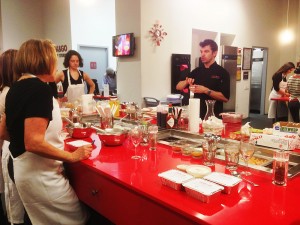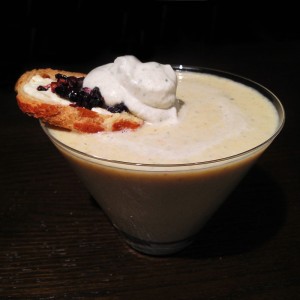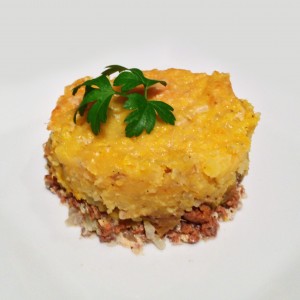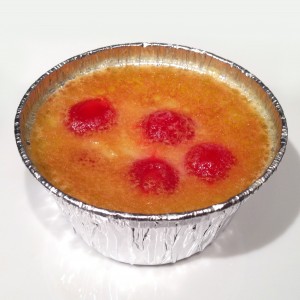Last week I had a fun time accomplishing two things at once with an awesome “cooking in French” workshop at Cook & Go in Manhattan. I discovered this through Fluent City, where I’m currently taking a French class and thought it would be great opportunity to bone up on my French culinary vocabulary while also learning some new French dishes. Cook & Go’s concept is simple but great for a busy New Yorker: you spend a couple hours assembling a menu of a few courses. Some of the annoying prep is taken care of for you already, and the remaining execution is planned out in a way that makes it approachable for even a novice chef. When you’re done with the class, you end up with a set of containers in a takeout bag along with easy instructions on how to pop them in the oven and finish the cooking at home. Bon appétit! (Btw, they started in France but since this is NYC most classes are in English, and the cuisine options are geographically diverse.)
The first course was an artichoke velouté. A velouté sauce (pronounced vel-oo-tay) is one of the five “mother sauces” of French cooking… or so claimed this dude in the 19th century. The name means “velvety” and the basic sauce version is pretty simple. You take a light stock such as chicken or fish and mix it into an equally light roux of butter and flour – one that’s just barely cooked as opposed to dark cajun style. The soup version is pureed artichokes, chicken broth, and cream. This on its own is surprisingly flavorful, but then we prepared a cumin chantilly (a savory whipped cream) to drop into it and some toasts with mozzarella/olive/sundried tomato to have alongside. These three things together provide some amazing flavor counterpoints, and in fact I had to make it again the next day at home just to re-live the experience.
The second course was a beef parmentier (par-mon-tee-ay), which is essentially French shepherd’s pie. The Cook & Go variation had squash mixed in with the mashed potato topping for a sort of new world flair. The base of cooked ground beef gets red wine, shallots, parsley and garlic mixed in plus eggs as a binder, then a mixture of mashed potato / squash / cream / nutmeg is layered over it and topped with cheese. During the controlled chaos of a multi-lingual group the crucial red wine was inadvertently omitted, but Chef Willy Johnson stepped in with a little System D and helped us inject it in via squeeze bottle at the end. This actually ended up being a happy accident because the finished dish had pockets of wine that weren’t evenly mixed in. That in turn let me taste the difference that the wine brings to the meat… the areas with the wine reduction lent a rich savory flavor as it combined with the meat juices and demonstrated just what a crucial ingredient it was to the flavor of the dish.
Finally, dessert consisted of a cherry clafoutis (cla-foo-tee). I’d encountered clafoutis before as a sort of tart, but this one was more a custardy flan. Cook & Go ingeniously gives you a tin pan to drop your little clafoutis into in order to make a bain marie (water bath). When I brought it home and heated it up in the oven, the butter and sugar miraculously rose to the top and formed a crust akin to a crème brûlée. Parfait!
Finally, a bit of the French vocab lesson… as it turns out, the French have a lot of different words for what we would simply call mincing or dicing, and given their culinary influence these have become terms commonly used by professional chefs. We practiced a brunoise (broon-wahz), which is a very fine dice or mince. If you do the same thing to a shallot or onion, it suddenly becomes ciselée (seize-a-lay), which is an adjective you can also use to describe minced herbs. But a thin slice of the same items is to emincer (eh-mon-say). A concasser (con-cah-say) is a coarse chop, while a macedoine (ma-seh-dwan) is a mixed dice of fruits or vegetables. That’s not to mention the juliennes, batonnets, allumettes or ponts neufs you might get if you choose to chop things into sticks. My conclusion? If the Eskimos can have fifty words for snow, then it’s not surprising that that a country with such a rich culinary history can get that descriptive with something as simple as chopping.
Cook & Go is at 443 W 16th Street in Chelsea, or all over France.




Fantastic post! I’m sorry I missed it. Hope they do it again soon.